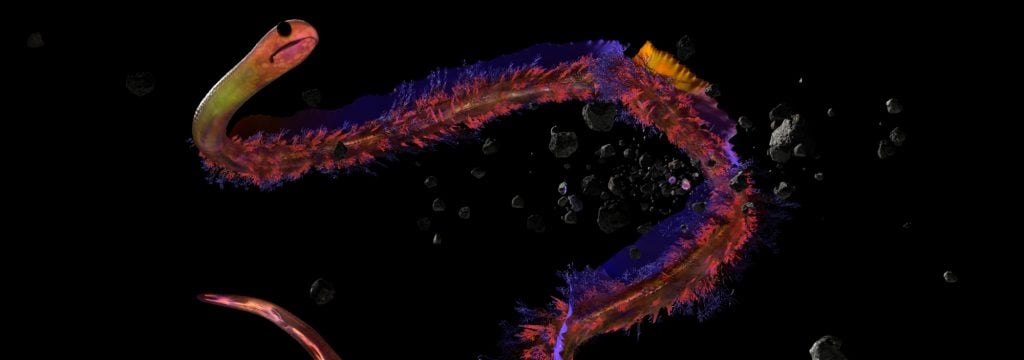Venice, with its interlocking islands threaded through with canals, is so singular, so breathtaking, and, during the Biennale, so busy, it feels like an insular world unto itself. Yet, entering Josèfa Ntjam’s swell of spæc(i)es, an art-weary traveller will feel all sense of time and place melt away as they are teleported towards unexplored galaxies and obscure ocean depths. The large purpose-built pavilion in the courtyard of the Accademia di Belle Arti is like a sedating cocoon replete with mountainous, soft grey sofas on which to flop.
Speaking to the French artist during the show’s installation felt a bit like slipping into a trancelike state, so seamlessly did her conversation skip between realms of bewildering magnitude. That day’s to-do list started to feel a little trifling once her stories sent my mind spinning between amazing revelations about primordial life to the greatest enigma of all: outer space. “It’s one of my favorite games,” she said with a smile.

Still from Josèfa Ntjam, swell of spæc(i)es (2024) at the 60th Venice Biennale. Image: LAS Art Foundation.
You’ll find that her immersive installations, which have made her one of the more in demand artists of the moment, have a similar effect. Commissioned by LAS Art Foundation, swell of spæc(i)es centers around a 20-minute animated film displayed across a long, curved LED wall. The narrative begins with plankton swirling in a dark abyss and mingling, improbably, with a floating fleet of meteorites. Is this deep sea or deep space? The influence of science fiction is immediately apparent, and it was no surprise to learn that Ntjam is a big Battlestar Galactica head.
No longer anchored in reality, the viewer encounters an interstellar, orange and purple snake with billowing, featherlike fins rendered in mesmerizing detail. The creature is at once recognizably of our world and yet, in this improbable context, an unearthly alien. As its mouth gapes open, we are launched into the belly of the beast where we drifting past rising ribbons of seaweed in psychedelic colors.
Eventually, this monstrous eel burps out an entire planet, which slowly spins towards us until we are exploring its prehistoric surface. This surreal narrative is accompanied by Fatima al Qadiri’s original score, which gently lulls then enlivens the viewer with emphatic violins. Meanwhile, two sonic jellyfish sculptures emit Ntjam’s poetic recitations.
Installation view of Josefa Ntjam’s swell of spæc(i)es (2024), a collateral event at 60th Venice Biennale. Commissioned by LAS Art Foundation. Photo: Andrea Rossetti, courtesy the artist, LAS Art Foundation, © ADAGP, Paris, 2024.
Born in 1992 in Metz to a French-German mother and a Cameroonian father, Ntjam grew up in a suburb of Paris. Her parents went out of their way to foster a creative atmosphere, putting on makeshift art classes in the local museums and taking Ntjam to see theatrical performances. She began playing clarinet at the age of 6, eventually attending a specialist high school where half of the day was spent in music conservatory.
Some years later, Ntjam was able to combine her various creative talents thanks to the unrestrictive, multidisciplinary curriculum of the art school ENSA Bourges, where she completed her Masters. “It was one of the schools with the most audio and video equipment in France, so I was super excited to be there,” she recalled. Ntjam’s photographic and sculptural work took on a sharper conceptual focus during a year abroad in Dakar, Senegal, where most of her classes were on cultural and political theory.
The university was named after the prominent Senegalese scholar Cheikh Anta Diop who proposed that ancient Egypt had been co-opted by the West, which wilfully failed to to acknowledge that the early civilization had been populated by sub-Saharan Black people. Diop believed that Africa should reclaim its rightful legacy and these ideas pushed Ntjam to interrogate European museum collections. Why did they always separate African and ancient Egyptian artifacts into different departments?
Josèfa Ntjam statues made in 2016. L-R: Scribe, Roi Aménophis III Ekumaté, and Figure de reine nubienne, part of Archeologie-s fictive-s d’histoire-s connecté-e-s (2017). Photo courtesy of Josèfa Ntjam Studio.
One of Ntjam’s earliest works is the photomontage Musée des Inter-Nets (2014), which merged images of actual Egyptian and African statues to make category-defying, imagined antiquities. These hybrids took physical form in Archeologie-s fictive-s d’historie-s connecté-e-s (2017), a series of carved wooden sculptures made during a stay in the artisanal village of Tambacouda. They were presented with labels in a mock museum made to look like an assembled stage set. In this way, Ntjam satirized the Western obsession with constructing narratives of “authenticity” around ethnographic objects.
Ntjam was also drawn to the use of Egyptian symbolism in art by the African Diaspora, like the title track and album cover of jazz musician Alice Coltrane’s Ptah, the El Daoud (1970) or scenes by the great pyramids in Spike Lee’s Malcolm X (1992). Nothing was more influential on Ntjam than the jazz composer Sun Ra’s interdisciplinary approach, which incorporated film, poetry, and sound. “I was wowed by how he linked ancient Black Egypt to the present but also the future,” she said. This play with shifting temporalities recalled the work of science fiction writer Octavia Butler, whose book Kindred (1979) is one of Ntjam’s touchstones. Elsewhere in our conversation she referred to the late 20th century Afrofuturist myth of the Drexciyans, deep sea descendants of the pregnant African women who were thrown overboard during the Middle Passage.
Josèfa Ntjam, A constellation of blackness performance at Forma, London in 2023. Photo: Sam Nightingale, courtesy of Josèfa Ntjam Studio.
She began assembling various fictions, histories, and perspectives into her poetry, which were combined with music to create performance pieces like In Conversations with Mami Wata, “a super intimate conversation” between herself and the African water spirit. Inspired by the figure of the “griot,” a traditional West African oral historian and storyteller, Ntjam said, “My performance is not about the body in space, my voice is not me, its a plural character that I use. It’s about how I can deconstruct my own representation as a performer.”
Perhaps Ntjam’s greatest skill is her ability to weave science fiction out of scientific fact, knowing instinctively where to look. How often do most people think about something so mundane as plankton? To Ntjam, it is worthy of wonder. For one thing, the bioluminescence of plankton can be watched by satellite, allowing us to track the currents. We can’t help but admire majestic rock formations, but these are the result of plankton across the eons slowly sedimenting into limestone. “This is the point where biology turns into geology, it’s a process of transformation,” said Ntjam, breathlessly.
“I really like the story that we can consider plankton as carriers of memory, because I really think there is so much memory at the bottom of the ocean,” said Ntjam.
Installation view of Josefa Ntjam’s swell of spæc(i)es at 60th Venice Biennale 2024, commissioned by LAS Art Foundation. Photo courtesy of LAS Art Foundation.
There is certainly something enchanting in the idea that humble plankton can turn otherwise transient moments in time into soaring mountains. That may be Ntjam’s artistic interpretation, but she has used the already sublime, mysterious ways of the natural world to craft a myth that relies on surprisingly little magical thinking.
As she was developing swell of spæc(i)es, Ntjam was inspired by the Dogon deity Amma who created stars by flinging clay into the sky. “It’s about the genesis of the world,” she said. “This is how everything was created. Clay contains a lot of micro-information like bacteria.” Once again, the micro becomes the macro. “It’s part of the endless cycle of transformation,” said Ntjam. “Everything you will see is endless transformation.” In Ntjam’s film, Amma is represented by a large, brooding octopus.
When the artist learned that, in 2016, astronomers discovered a planet encrusted in limestone, it was the missing part of the puzzle. Limestone is usually created by the sedimentation of plankton. This made her question whether these oceanic lifeforms have somehow existed elsewhere in the universe. Ntjam’s art prods at the unknown, revealing how closely folklore and fact can be aligned. She referred to how, observing space without modern tools, the Dogon people were able to identify previously unknown phenomena like the star Sirius B. Its existence was later confirmed by Western astrophysicists.
Installation view of Josèfa Ntjam’s “Futuristic Ancestry: Warping Matter and Space-time(s)” at Fotografiska New York. Photo: Dario Lasagni.
At a second-site near the Giardini, Ntjam has created an interactive experience for swell of spæc(i)es that allows users to use an iPad interface to select an image of plankton and African artifact. A custom AI algorithm will then combine the two to create an unlikely new acquatic entity that, once published, occupies a digital tank stretching in kaleidoscopic color across one wall of the gallery space.
Alongside a star turn in Venice, Ntjam is having her U.S. museum debut at Fotografiska New York with “Futuristic Ancestry: Warping Matter and Space-time(s)“, through May 2024. Vast, dense photomontage dioramas merge archival footage with AI-generated imagery alongside biomorphic sculptures. The installation also takes stateside Ntjam’s recent film Matter Gone Mild (2023), in which the artist appears and addresses her audience, channeling a chorus of real life heroes, age-old legends, and divinities.
“I am a multitude of shades of blackness,” Ntjam declares. “I’d like to not need the light to prove my existence, my absence, diffracted, hypothetical anti-matter, anti-thesis, anti-everything, I don’t introduce myself anymore. I couldn’t care less. Because I am a multitude of shades of blackness.”
Josèfa Ntjam’s “swell of spæc(i)es” is a collateral event of the 60th Venice Biennale running from April 20 through November 24, 2024.
Follow Artnet News on Facebook:
Want to stay ahead of the art world? Subscribe to our newsletter to get the breaking news, eye-opening interviews, and incisive critical takes that drive the conversation forward.

